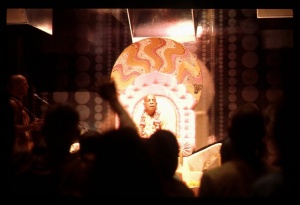CC Madhya 20.390: Difference between revisions
m (1 revision(s)) |
No edit summary |
||
| Line 1: | Line 1: | ||
{{ | [[Category:Sri Caitanya-caritamrta - Madhya-lila Chapter 20|C390]] | ||
<div style="float:left">'''[[Sri Caitanya-caritamrta|Śrī Caitanya-caritāmṛta]] - [[CC Madhya|Madhya-līlā]] - [[CC Madhya 20|Chapter 20: Lord Śrī Caitanya Mahāprabhu Instructs Sanātana Gosvāmī in the Science of the Absolute Truth]]'''</div> | |||
<div style="float:right">[[File:Go-previous.png|link=CC Madhya 20.389|Madhya-līlā 20.389]] '''[[CC Madhya 20.389|Madhya-līlā 20.389]] - [[CC Madhya 20.391|Madhya-līlā 20.391]]''' [[File:Go-next.png|link=CC Madhya 20.391|Madhya-līlā 20.391]]</div> | |||
{{CompareVersions|CC|Madhya 20.390|CC 1975|CC 1996}} | |||
{{RandomImage}} | |||
==== TEXT 390 ==== | ==== TEXT 390 ==== | ||
<div | <div class="verse"> | ||
eka-dui-tina-cāri prahare asta haya | :eka-dui-tina-cāri prahare asta haya | ||
cāri-prahara rātri gele punaḥ sūryodaya | :cāri-prahara rātri gele punaḥ sūryodaya | ||
</div> | </div> | ||
| Line 12: | Line 16: | ||
==== SYNONYMS ==== | ==== SYNONYMS ==== | ||
<div | <div class="synonyms"> | ||
eka-dui-tina- | ''eka-dui-tina-cāri''—one, two, three, four; ''prahare''—in ''praharas''; ''asta haya''—the sun sets in the evening; ''cāri-prahara''—generally after four ''praharas''; ''rātri''—the night; ''gele''—when it passes; ''punaḥ''—again; ''sūryodaya''—the sun rises. | ||
</div> | </div> | ||
| Line 19: | Line 23: | ||
==== TRANSLATION ==== | ==== TRANSLATION ==== | ||
<div | <div class="translation"> | ||
“The day and the night are divided into eight praharas—four belonging to the day and four belonging to the night. After eight praharas, the sun rises again. | “The day and the night are divided into eight praharas—four belonging to the day and four belonging to the night. After eight praharas, the sun rises again. | ||
</div> | </div> | ||
__NOTOC__ | |||
<div style="float:right; clear:both;">[[File:Go-previous.png|link=CC Madhya 20.389|Madhya-līlā 20.389]] '''[[CC Madhya 20.389|Madhya-līlā 20.389]] - [[CC Madhya 20.391|Madhya-līlā 20.391]]''' [[File:Go-next.png|link=CC Madhya 20.391|Madhya-līlā 20.391]]</div> | |||
__NOTOC__ | |||
__NOEDITSECTION__ | |||
Revision as of 03:36, 8 September 2021
Śrī Caitanya-caritāmṛta - Madhya-līlā - Chapter 20: Lord Śrī Caitanya Mahāprabhu Instructs Sanātana Gosvāmī in the Science of the Absolute Truth

His Divine Grace
A.C. Bhaktivedanta Swami Prabhupada
A.C. Bhaktivedanta Swami Prabhupada
TEXT 390
- eka-dui-tina-cāri prahare asta haya
- cāri-prahara rātri gele punaḥ sūryodaya
SYNONYMS
eka-dui-tina-cāri—one, two, three, four; prahare—in praharas; asta haya—the sun sets in the evening; cāri-prahara—generally after four praharas; rātri—the night; gele—when it passes; punaḥ—again; sūryodaya—the sun rises.
TRANSLATION
“The day and the night are divided into eight praharas—four belonging to the day and four belonging to the night. After eight praharas, the sun rises again.